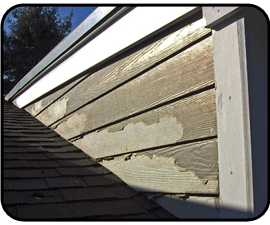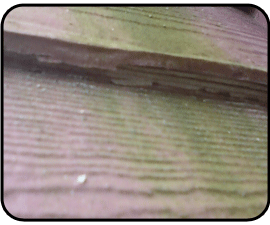Composite wood siding can be made of a variety of wood materials, such as saw dust or wood chips, compressed into planks or boards. It’s a popular option for new homes and remodeling projects. Composite siding can be fashioned to look like natural lumber planks or shingles, and can be painted with a variety of lustrous colors. It’s typically inexpensive and easy to find. However, there are a few things you should know about composite wood siding.
 The number one thing to remember is that composite wood siding is vulnerable to moisture.
The number one thing to remember is that composite wood siding is vulnerable to moisture.
Different composite blends contain different amounts of wood particles. They also make use of various protective sealants that can enhance their performance and increase their resistance to moisture, but the fact remains that wood is absorbent. Moisture will cause:
- Warping
- Swelling
- Rot
- Mold or fungus growth. (Not only does this compromise the integrity of the siding, but mold and mildew pose health hazards.)
When particles are compressed into composite boards, minuscule spaces between particles create openings that can absorb water from rain, sprinklers, garden hoses, and even humidity. Some composite siding installation also leaves gaps between the boards, which can allow for even greater moisture penetration. Even fiber-cement, one of the most durable composite sidings available, incorporates some wood particles, and is vulnerable to moisture.
Composite Wood Siding Options: The Facts
- Cedar, hardwood and Masonit
 e. Many natural wood sidings, such as cedar, have natural antibacterial and antifungal properties that strengthen them against moisture, but even combined with protective sealants, this only goes so far. They're still prone to warping and eventual rot. They’re also not the best insulators, and may not prevent noise pollution and energy loss. While wood siding looks gorgeous stained or painted, it’s prone to fading and is relatively high-maintenance. OSB siding can rot to the point where it crumbles to the touch.
e. Many natural wood sidings, such as cedar, have natural antibacterial and antifungal properties that strengthen them against moisture, but even combined with protective sealants, this only goes so far. They're still prone to warping and eventual rot. They’re also not the best insulators, and may not prevent noise pollution and energy loss. While wood siding looks gorgeous stained or painted, it’s prone to fading and is relatively high-maintenance. OSB siding can rot to the point where it crumbles to the touch.
- Fiber-Cement. Fiber-cement composites usually incorporate silica, wood and cement. It’s durable but again, may experience moisture issues. Absorbed moisture may evaporate slowly from fiber-cement, which can crack in cold weather. The planks are often cut on site, creating an airborne, silica-based dust dangerous to inhale, and their weight can cause buckling that creates a warped exterior look.
About Everlast Composite Siding
Everlast is a composite siding incorporating no wood particles whatsoever in its composition. Instead, it’s comprised of a blend of polymeric and inorganic minerals that resist moisture altogether. It’s material that results in one of the strongest, most durable composite blends on the market today. Everlast Composite is durable, and resistant to dents or chips. It’s a thick, product (500% thicker than vinyl) that reduces noise pollution. Colored-through, it warrantied not to fade substatially or chip. Compared with other options, Everlast is the being chosen more and more.
Composite wood siding options offer a a few benefits over traditional wood, but keep the drawbacks in mind, and consider investing in Everlast Composite siding for your home.
Author: Peter Martino





